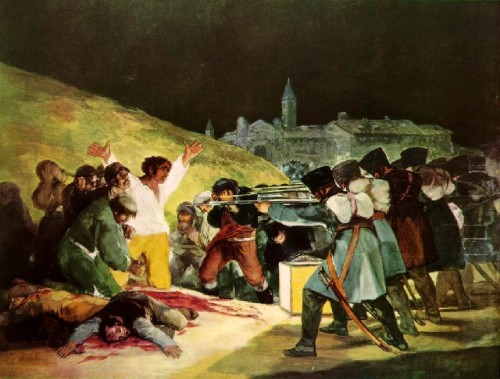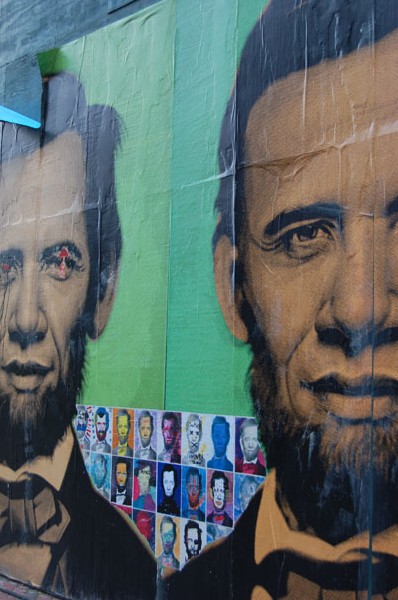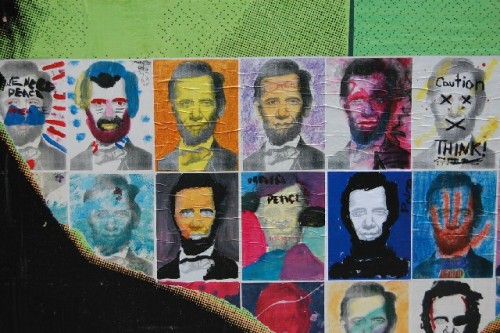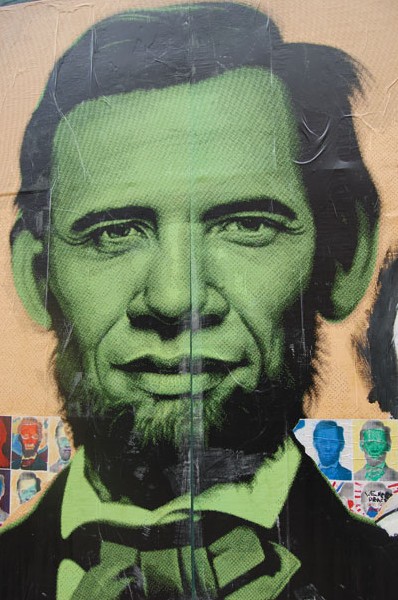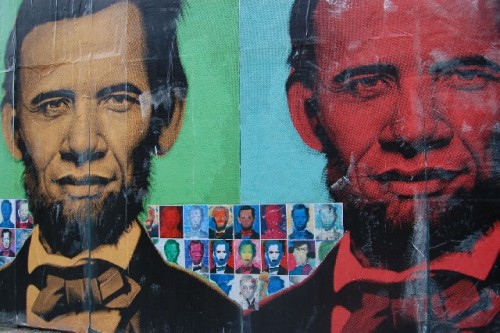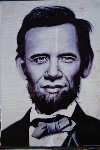Abraham Obama Morphes Art and Politics
Ephemeral Public Art in a Time of Angst
By: Mark Favermann - Aug 17, 2008
An intriguing, provocative, large scale art piece, by Ron English, was installed in July in Boston's South End neighborhood. The project is a series of repeated large portraits morphing Barack Obama's face with Abraham Lincoln's. It is art intertwined with politics, a transcendent Post Modern visual statement.
Political Art can mean a lot of things. Art that takes an ideological stand on a specific issue or addresses a public concern or just underscores viewers' sensitivity also can be considered political art. Certainly, artists throughout history have been called creators of political works. This term is often quite loosely applied. An artistic piece may be called 'political' because its subject or form causes a sensation, and it may be considered political because its subject matter pertains to a current event. The best political art has a special quality beyond the concept, the technique or sensationalism. It has a certain universal resonance.
Major examples of this notion are Francisco Goya's passionately charged The Third of May, 1808 (1814; Museo del Prado, Madrid), depicting French violence against Spaniards during the Napoleonic Wars, many of Honore Daumier's French political satire images that actually got him thrown in jail and Pablo Picasso's Gurnica about the pain and agony of war during the Spanish Civil War.
Another prominent creator of political art was Mexican artist Diego Rivera. Rivera was passionate from an ideological perspective. He was a communist. His mural Man at the Crossroads was begun in 1933 for the Rockefeller Center in New York City. He was dismissed from this commission at Rockefeller Center for including a portrait of Vladimir Lenin. Because of this, other US commissions were withdrawn or denied him. Political art often has major reactions and at times consequences to it.
Wall murals have often been statements of neighborhood aspirations, political ideology or moral philosophy. Wall murals have been interior décor elements since the Lascaux cave paintings were created. Murals can be purely decorative, cause or celebrate controversy or underscore ethnic or community pride. Starting in the 1970's coming out of 1960's radical poster art, there began a mural movement throughout the United States that underscored neighborhood pride, ethnic identity or idealistic concepts.
On July 4, 2008, the very provocative digitized print mural by artist Ron English was installed on a construction hoarding (temporary wall) at the Thayer Street complex in SOWA, the art gallery and studio district south of Washington Street in Boston's South End. Part of a 40 artist group show-- A Politic at Gallery XIV (37 Thayer Street), it is the repeated print of what is called "Abraham Obama." The 13 ft high by 100 ft long mural is made up of nine portrait repeats in different Warholic colors. The piece has generated incredible amounts of internet discussion, television pieces and print media not only in Boston, both nationally as well as around the world.
The two politicians have been expertly blended somewhat erasing the line between art and politics. The piece is about political and historical image and image-making. The exhibit curators' thought process was to commission the work to generate buzz for the gallery, stir discussion and stimulate controversy. They succeeded. The mural was commissioned by Will Kerr the Gallery XiV director. He was told by many not to do a political show. "They" said that it was the kiss of death as no one wanted to be visually lectured to during our lean times of political discontent. Clearly, "they" were wrong.
Ron English can be described as a 21st Century American Pop artist middle age bad boy. He primarily explores pop culture, brand imagery and advertising as themes for his work. Technically gifted, English often installs his works in places not specifically for fine art like inner city empty lots, existing billboards, bus shelters or construction sites—sometimes illegally. Not surprisingly, English takes inspiration from Andy Warhol and often references him in his work. He also uses as visual sources the band KISS as well as cartoons and sports figures. His inspiration also comes from urban posters and advertisements.
The artist has often referenced Picasso's Gurnica creating dozens of versions, transforming the original evocative Spanish civilian characters into Disney characters, Peanuts characters, soccer players, schoolchildren, as well as various others. English has a sense of humor. This Abraham Obama piece is being repeated in other American cities and will be on display in Denver, Colorado during the 2008 Democratic National Convention.
Here, the great liberator and the great articulator are combined. Lincoln changed America and Barack Obama's candidacy and possible election suggests great potential national and even world change. The comparisons and contrasts could go on and on. Review of the colors chosen can as well. The shifts in colors and values are somewhat Warhole-like. The varying colors suggest racial color undertones and nuances. There is a black and white unspoken reference in the color as well. Obama is of mixed race. All this is significantly and inherently visually stated in the mural.
English has an enthusiastic following who travel to see his new works sort of the way the Grateful Dead had its camp followers. Overly enthusiastic English's fans have pasted versions of the Abraham Obama image all over Boston's South End neighborhood angering some of the residents. Kerr has apparently received some very nasty mail about political influencing. This seems to suggest that something else is going on besides the visual clutter and perhaps vandalism of illegal bill posting. This is more about race and color than art and coloration.
This ephemeral piece is about the layers of art and politics. Not like an onion but more like a geological formation, the structural layers of this piece suggest how our society and body politic have been formed through inflated images, popular myths, perceived impressions and artful manipulations. This is a counter message to the rather buttoned down Post 9/11 lack of criticism fostered by the Bush Administration's national security mantra of no questioning or protest because it will be unpatriotic. Too bad, the conventional press and most of television organizations have bowed to this unAmerican notion of noncritical involvement for almost eight long years. This mural is a bit subversive.
What is neat about this image is that the artist is also asking us to look at the over elevation of a popular figure as well. By combining Lincoln and Obama, somehow we are visually integrating myth and man, history and potential as well as martyrdom and youthful vitality. Is the artist saying that the Obama supporters should beware as well?
Kerr has added additional images to the mural by having artists insert supplementary figures (including a broke Monopoly Man, aliens and screaming or crying women) to the mural and has incorporated drawings by middle school students to form an Abraham Obama collage. This is traditional grafitti as it should be, illustrating and protesting the ills of our time while celebrating a sense of our place in society.
After a month and half of summer sun and intermittent monsoon-like rains along with some slight vandalism, the Abraham Obama mural is deteriorating. It is high level temporary art that will eventually come down when Gallery XIV moves from its present quarters. During the exhibit, the gallery has been video documenting it. To those who were in the mural's presence, the image will be lasting and personally echoing. This resonating piece is not just an aspect of temporal public art, but it is something that touches our civic self and our generational history as well as our worrisome present and hopeful future.


